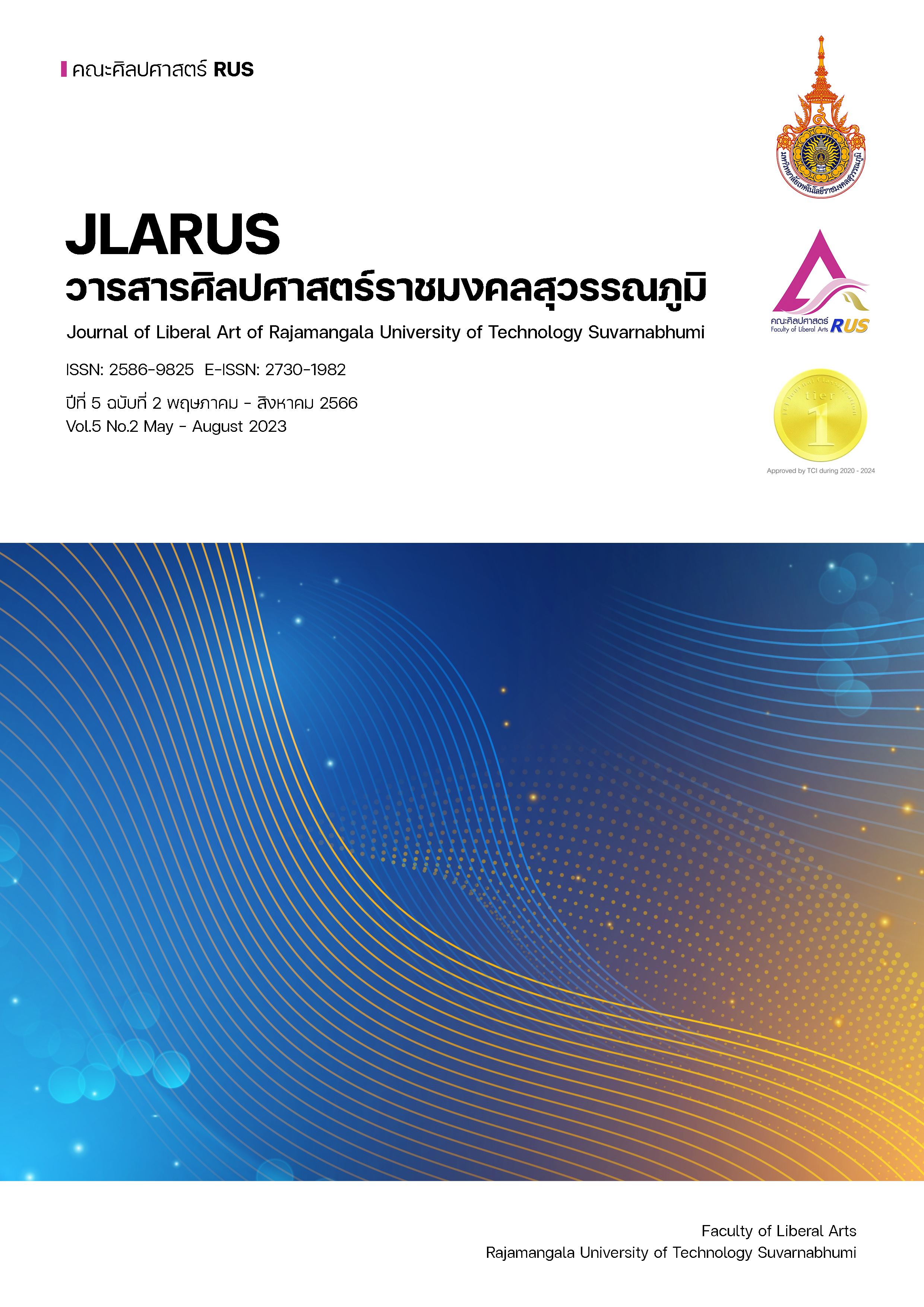องค์ประกอบของปัจจัยที่ส่งผลต่อพฤติกรรมการใช้บริการตลาดสด ในพื้นที่กรุงเทพมหานคร
Main Article Content
บทคัดย่อ
บทความวิจัยนี้ใช้ระเบียบวิธีแบบผสานวิธี เพื่อ 1) พัฒนาตัวบ่งชี้ปัจจัยที่ส่งผลต่อพฤติกรรมการใช้บริการตลาดสดในพื้นที่กรุงเทพมหานคร 2) วิเคราะห์องค์ประกอบของปัจจัยที่ส่งผลต่อพฤติกรรมการใช้บริการตลาดสดในพื้นที่กรุงเทพมหานคร และ 3) ประเมินความตรงเชิงโครงสร้างและความตรงเชิงจำแนกของแบบจำลองการวัดปัจจัยที่ส่งผลต่อพฤติกรรมการใช้บริการตลาดสดในพื้นที่กรุงเทพมหานคร โดยทำการวิจัยเชิงคุณภาพ โดยการสัมภาษณ์กลุ่มผู้ให้ข้อมูลหลัก จำนวน 12 คน เพื่อให้ได้ผลตามวัตถุประสงค์ข้อ 1 จากนั้นจึงทำการวิจัยเชิงปริมาณโดยการรวบรวมข้อมูลจากผู้บริโภคด้วยวิธีการเลือกตัวอย่างแบบหลายขั้นตอนจากตลาดสดขนาดใหญ่ในกรุงเทพมหานคร จำนวน 3 แห่ง รวมทั้งหมด 895 คน และใช้แบบสอบถามที่ผ่านการหาคุณภาพทั้งความตรงและความเชื่อมั่นแล้วเป็นเครื่องมือการรวบรวมข้อมูล หลังจากนั้นจึงวิเคราะห์ข้อมูลเชิงสถิติ ได้แก่ ค่าเฉลี่ย ส่วนเบี่ยงเบนมาตรฐาน ค่าความเบ้ ความโด่ง การวิเคราะห์องค์ประกอบเชิงสำรวจ และการวิเคราะห์องค์ประกอบเชิงยืนยัน
ผลการวิจัยพบว่า องค์ประกอบของปัจจัยที่ส่งผลต่อพฤติกรรมการใช้บริการตลาดสดในพื้นที่กรุงเทพมหานครมีจำนวน 9 องค์ประกอบ 39 ตัวบ่งชี้ ได้แก่ (1) ราคาสินค้า (2) คุณภาพสินค้า (3) อัธยาศัยของผู้ค้า (4) สุขอนามัยต่อสภาพแวดล้อม (5) การจัดการห้องน้ำ (6) การสื่อสารของผู้ค้า (7) การจัดการขยะ/น้ำเสีย (8) สุขอนามัยของแผงสินค้า และ (9) สถานที่จอดรถ ทั้ง 9 องค์ประกอบมีความกลมกลืนกับข้อมูลเชิงประจักษ์ มีความตรงเชิงโครงสร้าง และมีความตรงเชิงจำแนก ซึ่งแสดงว่าองค์ประกอบเหล่านี้สามารถนำไปใช้เป็นเครื่องมือสำหรับวัดความพึงพอใจของผู้บริโภคที่มีต่อตลาดสดอันจะนำไปสู่การบริหารจัดการที่ตอบสนองความต้องการของผู้บริโภคได้ดี
Article Details

อนุญาตภายใต้เงื่อนไข Creative Commons Attribution-NonCommercial-NoDerivatives 4.0 International License.
เอกสารอ้างอิง
กรมส่งเสริมการปกครองท้องถิ่น กระทรวงมหาดไทย. (มปป.). มาตรฐานตลาด. สืบค้น 9 กุมภาพันธ์ 2564. จาก https://www.sa-kwan.go.th/FilesUploads/12052020_160512มาตรฐานตลาด.pdf.
กระทรวงสาธารณสุข. (2564). เกณฑ์การพิจารณาในการรับรองตลาดสด น่าซื้อ และแบบประเมินการพัฒนายกระดับตลาดสด น่าซื้อ. สืบค้น 15 พฤษภาคม 2564. จาก https://food san.anamai.moph.go.th/th/healthy-market/204499.
พงศ์เมธ ล่องเซ่ง. (2566). ปิดตลาด ซ้ำเติมผู้มีรายได้น้อย. สืบค้น 12 กุมภาพันธ์ 2566. จาก https://theactive.net/news/20210105-4/.
รัตนาภรณ์ เพชรกุล ศรัณยา นาคแก้ว และ เสาวคนธ์ ศรีสุคนธรัตน์. (2564). กลยุทธ์การกำหนดราคาที่ส่งผลต่อกระบวนการตัดสินใจซื้อเสื้อผ้าแฟชั่นในสถานการณ์ covid–19 ของผู้บริโภคเขตอำเภอเมืองจังหวัดภูเก็ต. วารสารวิชาการสัคมมนุษย์ มหาวิทยาลัยราชภัฏนครศรีธรรมราช. 11(1), 26-44.
สยานนท์ สหุนันต์, ศิวกร ญาวิโรจน์, เฉลืมพงษ์ ชวนะภูธร, และกัลยา สร้อยสิงห์. (2564). ปัจจัยความสำเร็จในเชิงธุรกิจของตลาดสด กรณีศึกษาตลาดสดใหม่นาเกลือ อำเภอบางละมุง จังหวัดชลบุรี. วารสารวิทยาลัยดุสิตธานี. 15(2), 145-161.
สำนักสุขาภิบาลอาหารและน้ำ กรมอนามัย กระทรวงสาธาธารณสุข. (2564). ผลการดำเนินงานพัฒนาตลาดสดน่าซื้อประจำปี 2561. สืบค้น 9 กุมภาพันธ์ 2564. จาก http://foodsan.anamai. moph. go.th/main.php?filename=index2017.
อัมพร จันทวิบูลย์. (2560). การพัฒนาตลาดสดเพื่อคุณภาพชีวิต ภารกิจความร่วมมือของประชารัฐ. วารสารสุขาภิบาลอาหารและน้ำ. 8(2), 2-4.
Creswell, J. W. (2007). Research design: qualitative, quantitative, and mixed methods approaches. Thousand Oaks: Sage.
Creswell, J. W. (2012). Qualitative inquiry and research design: Choosing among five approaches. Sage. Publications, Inc.
Denis, D. J. (2021). Applied Univariate, Bivariate, and Multivariate Statistics Understanding Statistics for Social and Natural Scientists, With Applications in SPSS and R. John Wiley & Sons.
Fornell, C. & Larcker, D.F. (1981). Evaluating Structural Equation Models with Unobservable Variables and Measurement Error. Journal of Marketing Research, 18, 39-50.
Hair, J. F. et al., (2010). Multivariate Data Analysis. Hampshire, Cengage Learning EMEA.
Kotler, P., & Armstrong, G. (2013). Principles of marketing (15th ed.). Pearson Prentice Hall.
Kotler, P., & Keller, K. (2006). Model of consumer's behavior Marketing management (12th ed.). New Jersey: Pearson Prentice Hall.
Muthén, L.K., & Muthén, B. (2023). Mplus User’s Guide Chapters with Example. Retrieved February 12, 2023, from https://www.statmodel.com/ugexcerpts.shtml.
Nastasi, B. K., & Schensul, S. L. (2005). Contributions of qualitative research to the validity of intervention research. Journal of School Psychology. 43 (3), 177-195.
Nunnally, J. C. (1978). Psychometric Theory (2nd ed.). New York: McGraw-Hill.
Schumacker, R. E., & Lomax, R. G. (2004). A beginner's guide to structural equation modeling (2nd ed.). Lawrence Erlbaum Associates Publishers.
Tabachnick, B. G., & Fidell, L. S. (2007). Using Multivariate Statistics (5th ed.). Pearson International Publishing.


